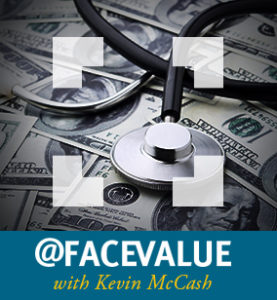Show Me the Money!
 The last few posts that I have made here on @FaceValue have focused on the technological advances and data techniques that could help the value-based healthcare (VBH) concept really come into its own. It’s all well and good to talk about this cool thing and that great idea but when it comes to brass tacks it’s all about those dolla dolla bills y’all.
The last few posts that I have made here on @FaceValue have focused on the technological advances and data techniques that could help the value-based healthcare (VBH) concept really come into its own. It’s all well and good to talk about this cool thing and that great idea but when it comes to brass tacks it’s all about those dolla dolla bills y’all.
Usually when someone starts talking about healthcare costs they start at the patient level e.g. “How much would your care cost.” I am not going to take that approach but will instead start talking about things from a provider standpoint and then branch out into the other parts of the industry. Why you ask? Well the answer is simple. I want to make the case that data management, analysis, and advanced machine learning techniques can have very local effects as well as broader spectrum influences through a sort of Keynesian-esque “trickle out” effect. Healthcare is a very complex micro-economic system that exists in large part autonomously from a lot of other consumer industries. While I know my way around a supply and demand graph I certainly don’t purport to be an economist. For that reason any discussion that follows should definitely be taken lightly and not necessarily as expert opinion.
So let’s get down to the nitty gritty shall we? Unless you own or run a medical provider location in the U.S., it is difficult to imagine just how much it costs to operate such a business. It is much easier, however, to understand what drives those costs from a layperson’s perspective. Outside of the obvious supply requirements and general maintenance or utility costs, the largest cost that a healthcare provider is likely to encounter is through that of administration. This would include personnel like billing and coding specialists, insurance specialists, management, and reception where applicable. All of the people, technology, and time cost quite a bit as you can imagine. For example, administrative work is estimated to be around 25% of the total hospital expenditure in the United States which comes to something to the tune of hundreds of billions (with a B) of dollars nationwide.
What does that have to do with VBH? Well, honestly, not a whole lot. However, using advanced data mining and machine learning techniques, all of that administrative work could be dramatically streamlined and costs reduced. The only investment to make would be on the tech infrastructure needed to accommodate the application of advanced techniques in administrative work which unfortunately is not necessarily a cheap one. From a long term planning perspective, a significant investment to help reduce administrative costs (even by a few percent) would result in large monetary gains for the provider and institutional entities in healthcare over a few years. The benefit you ask? Well, lowering operational costs would lower service costs and jumping a few steps would lower out-of-pocket costs for patients.
An added benefit of that type of investment is that now hospitals and other provider groups would have the infrastructure built into their operation that could be dual-purposed for use in designing value-based methodologies to exact better outcomes for patients. Now we have what I like to call a “double-whammy” where costs have been reduced on the operational side and outcomes can be improved for the patient side as well. I bet you guess where I am going next.
If the operational costs are reduced and payers are incentivizing providers to improve patient outcomes then there is cost reduction on two fronts and the net result would be, you guessed it, a HUGE return on investment and an overall decrease in healthcare expenditure across the board. Now if this sounds a little too good to be true, that’s probably because it is-at least to some extent.
While technically possible and reasonably sound, logically speaking, plans like this almost never come without a few obstacles. The biggest reason being the wide array of providers, provider groups, and hospitals that exist in the U.S. today. Many such entities do not have a way to manifest the necessary capital for the investment in IT infrastructure needed for such changes. At least not without compromising their ability to operate right away. Couple that with hesitancy to adopt machine learning and data analysis techniques wholesale and a general lack of existing products and services in this area and we have a problem. Regardless, given a little time and the changing landscape of commercial services entering the arena, and it is likely that we will start to see many inroads towards a more data-centric mentality in the coming years. So while I would love to say this is a “here and now” idea I just can’t do it. Believe me though, that won’t stop me from doing my best Jerry Maguire impression.







Kevin, so proud of your commitment and support in your work at Qlarant! I really enjoyed knowing you before I retired. Continued success to you in your future.
Hey Nancy, it is nice to hear from you! I appreciate the kind words. I sure hope retirement is treating you well. If not you let me know and I will see if I can’t talk some sense into it.